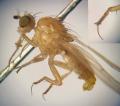Diptera.info :: Identification queries :: Diptera (eggs, larvae, pupae)
|
fly larvae in sandy soil
|
|
| Keith Short |
Posted on 06-04-2013 02:33
|
|
Member Location: Loves Park, Illinois, USA Posts: 37 Joined: 10.07.12 |
I need to prospect for fly larvae in sandy soil. Berlese funnels don't work well as the sandy soil falls through the screen wire when it drys and into the collection beaker. Is there a standard technique? I am considering "panning" for larvae (like panning for gold) using a wet technique to separate the dense sandy soil and a strainer to filter out the "organics" that float on top of the sand. Any suggestions would be greatly appreciated. I need a technique that allows me to separate them from the soil, photograph them then return them to soil so I can see what eventually emerges. Kind regards, Keith Short |
|
|
|
| Cranefly |
Posted on 06-04-2013 16:25
|
|
Member Location: Shachovskaya Posts: 647 Joined: 17.09.08 |
I wonder whether such "correct' and good technique exists. Soil zoologists use many methods for Diptera, among them a set of sieves with holes of different smaller diameter in each, floatation method, hand examination and thermoextraction. Many soft larvae are damaged and are to be fixated, because they are not in good condition for further rearing. Once I managed to catch Tabanus larvae, make photo of it and put it back in soil , then imago emerged (from single larva, i think it was good result). If you extract Therevidae or some other predatory larvae you are to feed it if you want to get imago. Sometimes I use the following: I take several samples from the same place, extract larvae from one of them, study, photo ot fix it, determine it to group (family, genus) and try to rare it. For control I collect all imagoes from other untouched samples and sometimes it works. It is a way to get male for example if you rare females etc.  |
|
|
|
| Keith Short |
Posted on 06-04-2013 19:06
|
|
Member Location: Loves Park, Illinois, USA Posts: 37 Joined: 10.07.12 |
Cranefly, Thanks for the reply. I don't think I can do a sieve method without damaging the larvae quite severely. I will try flotation next. I will also do some reading on soil zoology. Kind regards, Keith |
|
|
|
| Louis Boumans |
Posted on 28-04-2013 16:22
|
|
Member Location: NO Oslo Posts: 269 Joined: 09.06.04 |
Maybe it is an idea to place a sieve / mesh under the Berlese funnel, to separate the sand from larger items in a more gentle way than ordinary sieving.
Edited by Louis Boumans on 28-04-2013 16:22 |
|
|
|
| Jump to Forum: |












